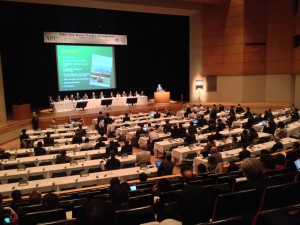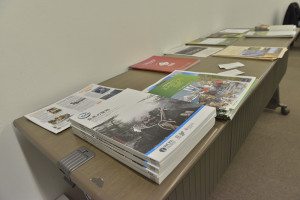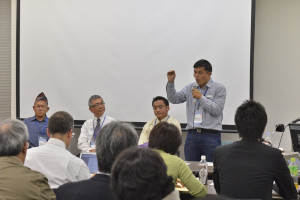
अगोदर निर्देश केलेल्या बाबीसंबंधी बोलताना Asian Parks Congress (APC), सेंदई शहरात आयोजित, जपान पासून 13 - 18व्या नोव्हेंबर 2013 स्वागत 800 पासून लोक 22 आशियाई देश आणि जगभरातील. The Sacred Natural Sites Initiative and WCPA Japan hosted a dedicated working group session and a side event that discussed the rich and diverse dimensions of sacred natural sites in Asia. Preparatory inputs into the World Parks Congress were made and steps were taken towards establishing an Asian Sacred Natural Sites Network. Sacred Natural Sites overall achieved a high profile within the APC and substantial mention within the Congress outputs.

“An Asian Philosophy of Protected Areas” was the title of the keynote presentation from Professor Amran Hamza, from Malaysia at the opening session of APC. स्रोत: खोल Verschuuren.
“We recognize that many cultures and religions originating in Asia have a deep reverence for natural features and phenomena, and have created sacred natural sites that are protected and managed by local communities. These special places not only contribute to the spiritual richness and well-being of people and communities, but also play a valuable role in conserving biodiversity and ecosystem services”. स्रोत: The Charter of Asian protected Areas.
"An Asian Philosophy of Protected Areas” was the title of the keynote presentation from Professor Amran Hamza, from Malaysia at the opening session of APC. It brought Sacred Natural Sites directly to the attention of all the participants of the Congress when he presented the historic Asian ethic of harmony between nature and humans. His presentation was based on his studies and publication on the subject, which draws on contributions of the IUCN Specialist Group on Cultural and Spiritual Values of Protected Areas.
A workshop on SNS was chaired by Robert Wild (SNSI) and Nao Furuta (IUCN Japan). Eight presentations were made featured some iconic sites from Japan, नेपाळ, Taiwan and Cambodia. As only last year the IUCN UNESCO Guidelines for Sacred Natural Sites were translated into Japanese. Japan was represented by case studies from two of Japans most Holy Mountains, Hakusan (Mt Haku) and Fujisan (Mt Fuji). The key questions of the side event were:
- संरक्षित क्षेत्रांच्या सांस्कृतिक आणि आध्यात्मिक मूल्यांवर IUCN WCPA विशेषज्ञ गटाच्या सहकार्याने पवित्र नैसर्गिक स्थळांचे आधुनिक महत्त्व आणि संदर्भासह संरक्षित क्षेत्रांचा सराव आणि ऑपरेशन यावर लक्ष केंद्रित केलेले गोषवारा आमंत्रित करतात., उदा. संरक्षित क्षेत्रांच्या सांस्कृतिक आणि आध्यात्मिक मूल्यांवर IUCN WCPA विशेषज्ञ गटाच्या सहकार्याने पवित्र नैसर्गिक स्थळांचे आधुनिक महत्त्व आणि संदर्भासह संरक्षित क्षेत्रांचा सराव आणि ऑपरेशन यावर लक्ष केंद्रित केलेले गोषवारा आमंत्रित करतात., संरक्षित क्षेत्रांच्या सांस्कृतिक आणि आध्यात्मिक मूल्यांवर IUCN WCPA विशेषज्ञ गटाच्या सहकार्याने पवित्र नैसर्गिक स्थळांचे आधुनिक महत्त्व आणि संदर्भासह संरक्षित क्षेत्रांचा सराव आणि ऑपरेशन यावर लक्ष केंद्रित केलेले गोषवारा आमंत्रित करतात.?
- संरक्षित क्षेत्रांसाठी वडिलोपार्जित पवित्र नैसर्गिक स्थळांची आधुनिक प्रासंगिकता काय आहे आणि हे कसे चांगले ओळखले जाऊ शकते आणि पारंपारिक पालकांना कसे गुंतवले जाऊ शकते?
- संरक्षित क्षेत्रांसाठी वडिलोपार्जित पवित्र नैसर्गिक स्थळांची आधुनिक प्रासंगिकता काय आहे आणि हे कसे चांगले ओळखले जाऊ शकते आणि पारंपारिक पालकांना कसे गुंतवले जाऊ शकते, संरक्षित क्षेत्रांसाठी वडिलोपार्जित पवित्र नैसर्गिक स्थळांची आधुनिक प्रासंगिकता काय आहे आणि हे कसे चांगले ओळखले जाऊ शकते आणि पारंपारिक पालकांना कसे गुंतवले जाऊ शकते?
-

जपानी आययूसीएन युनेस्को सेक्रेड नॅचुरल साइट मार्गदर्शक तत्त्वांच्या प्रती ज्या गटात काम चालू होते त्या बाजूला कार्यक्रमात प्रदर्शन. स्रोत: APC
The presenters are currently developing their presentations in to online case study descriptions च्या 1000 Words as well as 3000 word articles that will strengthen a publication on Asian Sacred Natural Sites which will be presented at the World Parks Congress in 2014. Bothe, the online case studies and the book are open to new submissions. In case you are interested please contact info@sacrednaturalsites.org.
The side event: A side event presentation was made by Bas Verschuuren and was followed by group work where participants discussed three main issues, the input into the Working Group 3 परिणाम, inputs to WPC and the potential for an Asian Sacred Natural Sites Network.
The participants to the side event agreed that an Asian Sacred Natural Sites Network would be very useful in working towards the World Parks Congress and possibly beyond. A number of potentially strong relationships were formed and it was agreed to start simply with an email group of an initial 40 contacts. The network aims to improve communications on and recognition of Sacred Natural Sites in protected areas and wider land and seascapes in the region. It will also focus on how to support Sacred Natural Sites at the World Parks Congress in Sydney next year and is open to new members with an interest of being involved (contact: info@sacrednaturalsites.org).
-

Jailab Kumar Rai is presenting on the role of Sacred Natural Sites and protected areas in Nepal. On the panel in the background are some of the other session presenters; श्री. Kamal Kumar Rai from Nepal, Professor Yi-Chung Hsu from Cambodia and Mr. Lama Neema from the Tsum Valley in Nepal. स्रोत: APC.
With the help of the Biodiversity Network Japan, the Sacred Natural Sites Initiative was able to sponsor a team of three Nepali’s to make a strong presence at the APC. Guardian Lama Nima from the remote Tsum Valley and his colleague Jailab Rai of Forest Action Nepal presented how the Tsum Valley was declared a sacred valley over a hundred years ago. Kamal Kumar Rai presented on the role of religion, spirituality and cultural values at Salpa Pokhari, a sacred Himalayan high altitude lake and key pilgrimage destination. Inspired by the diversity of management challenges of the Salpa Pokhari, Kamal Rai has now taken up the translation of the essential IUCN UNESCO Guidelines on Sacred Natural Sites into Nepalese.
Jailab Rai gave an extra presentation on the role of sacred natural sites in Protected Areas in Nepal. His presentation was but one example that illustrated the productive collaboration with the ICCA-Consortium and many of the case studies presented in the ICCA working session featured Sacred Natural Sites and many cases presented in the Sacred Natural Sites Session featured ICCAs.
A few days after the APC a very interesting excursion to Mt Fuji showed various different meanings of the sacred over time. The well known and iconic volcano and national symbol of Japan has been known for its special spiritual values to animist Shinto followers since times immemorial. श्री. Ono and Mr. Hongo from the Yamanashi Institute of Environmental Sciences showed the participants of the excursion how these Shinto beliefs fused with different strands of Buddhism and how this affected the various practices of worship on and around the mountain. As their work is currently under preparation we hope to be able to feature an online case study on Mt. Fuji in the near future.






